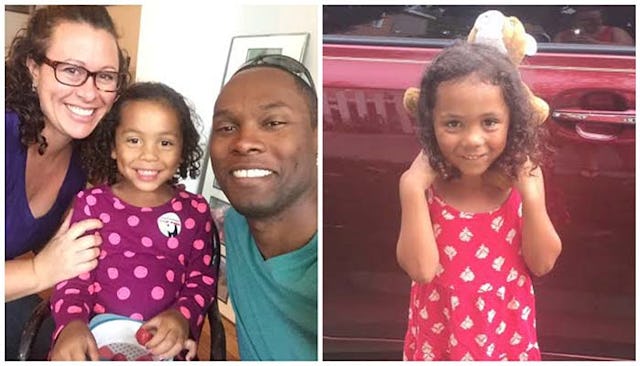Parents Of 5-Year-Old Transgender Girl Share Their Story And Show Us What Love Looks Like

Parents share their story in hopes of reaching other families who need support
When Ellie was three years old, she began wearing dresses. At first, her parents just thought they had a son who liked to play dress up.
“We really just thought we had a son who liked dresses and felt more himself in dresses. And we were okay with that,” explains Vanessa Ford, Ellie’s mom. “We were like, ‘well, this is his path.’ We now know it was her path.”
Ellie is a five-year-old transgender girl. Her parents are getting her story out for those who need to see it. “We saw a piece about a child transitioning young and it was the final thing that clicked for us to support Ellie in her transition,” Ford told Scary Mommy. Now, they hope to do the same for other families who need support. They also have a son, six-and-a-half-year-old Ronnie.
Image via Vanessa Ford
“For a long time, we said, ‘Our son likes dresses but also ninjas’ to describe our child to others,” Vanessa and her husband Ron Ford Jr. wrote in a letter to the school that Ellie attends. “However, we, and a number of experts and specialists, don’t feel that’s a fair description of our child anymore. Our child insists every day, in many ways that they are a girl and has for a long time. Our child has asked for us to call them her/she/sister and Ellie is a name she chose once she realized people would think she was a boy with her birth name.”
Starting around age four, Ellie “consistently and persistently” told her parents that she was a girl, in many ways. They explained in their letter that the clearest way Ellie described this was by saying, “I’m not a boy. I am a girl. I’m a girl in my heart and my brain.” They continued, “most times when she says these things, she says them without prompting or questioning. She draws herself as a stick figure girl, says she’s a girl–often many times a day when playing (“I’m the girl power ranger, I’m Wonderwoman/SpiderGirl/BatGirl etc). We purchased a whole “girl” wardrobe after a tantrum one morning about having to wear “boy” underwear. Since that point, our daughter has truly emerged. She has blossomed, is happier and just seems more herself. It’s hard to explain. (Ellie chose her new name by the way. It’s the name of her lovey and it means “shining light”!)”
“Ellie’s school has been a model of inclusiveness. No matter a student’s ethnicity, race, physical challenge, or other identity, her school actively works to embrace and celebrate differences,” Vanessa and Ron explained in an op-ed for The Washington Post. “Ellie has blossomed in her school. She feels safe, loved, empowered and, most importantly, just like every other kid there.”
But not all schools are like this, which is why we all need to push for safety and inclusivity in schools. “What if Ellie was forced to attend a school where adults were not only allowed, but empowered and encouraged, to discriminate against her? What if, because the adults were able to do this, the school transformed into a place where her peers could tease and bully our daughter without fearing consequences from teachers or staff,” her parents wonder.
Ellie is loved, cared for, and understood. If everyone could provide that feeling of safety and acceptance for their children, the world would truly be a better place. Acceptance breeds acceptance, and it’s something that should be taught to children from the youngest age, so that they know that everyone is deserving of love and the life they were meant to have.
In their letter to Ellie’s school, the Fords mention this horrifying statistic: Over 50% of transgender teens attempt suicide, even higher for teens of color like Ellie. They also mention that acceptance and support is the number one predictor of a child’s safety.
“We don’t see anything “wrong” with our daughter,” they conclude their letter. “This is the way our child was born and we love her… and hope the community around her in school, playgroups etc. will do so too.”
This article was originally published on